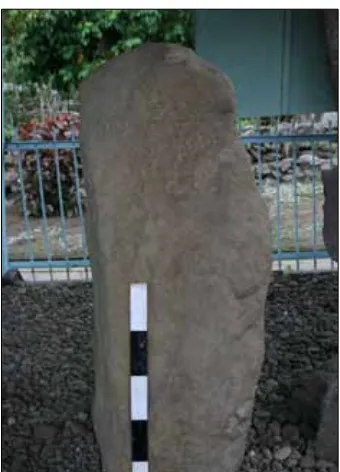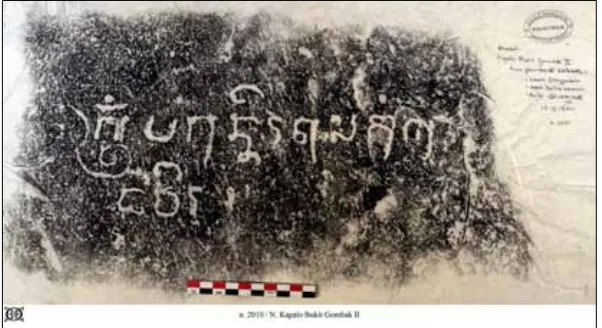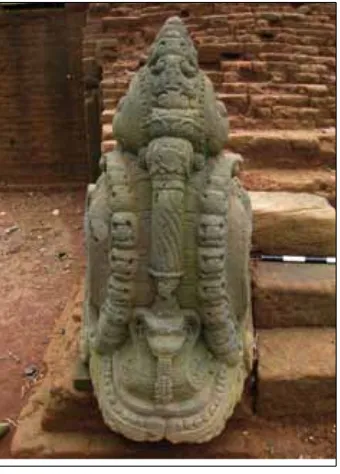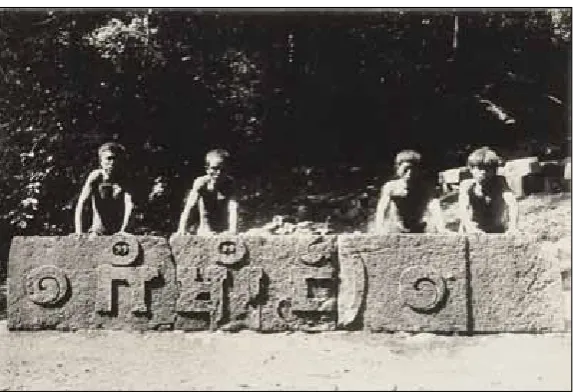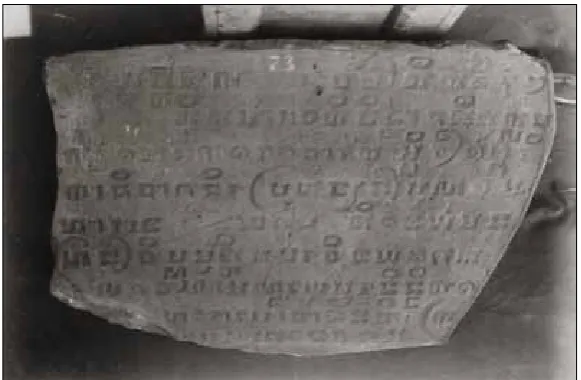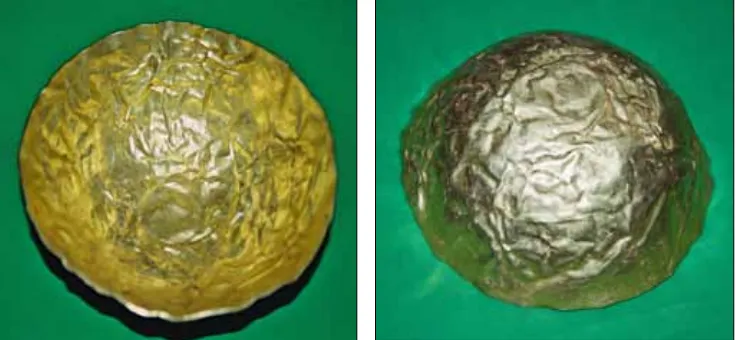© 2012 Faculty of Humanities, University of Indonesia
ARLO GRIFFITHS holds a doctorate in Indology from Leiden University (2004). He was professor of Sanskrit at Leiden University (2005–2008), and is professor of Southeast Asian History at the École française d’Extrême-Orient (French School of Asian Studies), posted at its Jakarta branch office, since 2008. In addition, he holds a position as adjunct professor in Indonesian Epigraphy at University of Indonesia since 2010. His research foci are the Sanskrit and vernacular language epigraphical sources of Southeast Asia, on the one hand, and Vedic (especially Atharvavedic) literature of India, on the other. Arlo Griffiths may be contacted at: [email protected].
Inscriptions of Sumatra
II. Short epigraphs in Old Javanese
ARLO GRIFFITHS
Abstract
This article documents the existence of inscriptions using Old Javanese language on the island of Sumatra, by editing three short epigraphs, the first of which has previously been published but never satisfactorily interpreted, while the remaining two have not yet been published at all. However short these texts are in themselves, they raise interesting questions about the cultural, commercial, political, and linguistic connections between Java and Sumatra in ancient times. Keywords
Old Javanese, Old Malay, Java, Sumatra, inscription, funerary monument, makara, saragi.
The two major literary languages of the Indonesian archipelago, Malay and Javanese, are associated – both factually and perceptually – with the two major
islands Sumatra and Java. The earliest written records of Sumatra, taking the form of inscriptions on stone, are indeed in Malay, while the earliest written records in an indigenous language found in Java are indeed in Javanese.1
Nevertheless, there are exceptions to this pattern of language distribution in the epigraphical record. The presence of a group of inscriptions in Old Malay originating from Central and West Java has drawn considerable scholarly attention;2 but the reverse phenomenon, the epigraphical use of Old Javanese
1 Several colleagues have helped me access the inscriptions discussed here, or shared with me their views on problems of interpretation. I gladly acknowledge the help of Agus Widiatmoko, Annabel Gallop, Budi Istiawan, Marijke Klokke, Daniel Perret, Uri Tadmor, and Jan Wisseman Christie.
on Sumatra, has hardly been investigated.3 In continuation of my research on
the epigraphical record of Sumatra (to be) published elsewhere,4 the purpose
of the present paper is to document the existence of the phenomenon, and in
so doing to present to the academic world three inscriptions, the first of which
has previously been published but never satisfactorily interpreted, while the remaining two have not yet been published at all. It will be shown that
no general explanation will be sufficient to cover the diversity of historical
scenarios leading to the presence of these artefacts on Sumatra.
1 Inscribed upright stone from West Sumatra
An inscription dating to about the period of Ādityavarman (fourteenth century
ce), currently held in the shelter of inscriptions at Pagaruyung in regency
(appendix B: “Śrīvijaya and the Old Malay inscriptions of Java”). See also Griffiths Forthcoming a.
3 The inscription of Hujung Langit in Lampung, still unpublished, was initially considered to have been written in Old Javanese, but Louis-Charles Damais later showed (1962a) that it is written in Old Malay. One or two short inscriptions from Padang Lawas, in North Sumatra, have been misidentified as being in Old Javanese. On this misidentification, see Griffiths Forthcoming b.
4 My review article “Inscriptions of Sumatra: Further data on the epigraphy of the Musi and Batang Hari River Basins“ (Griffiths 2011) is hereby retroactively declared the first instalment of this series of studies dealing with Sumatran epigraphy. See also Griffiths Forthcoming b.
Tanah Datar, West Sumatra (Figure 1), and originally recovered from the site Kapalo Bukit Gombak not far from Pagaruyung, was listed as number 28 in Krom’s “Inventory of the antiquities in the Padang Highlands” (1912: 43). Krom there proposed the reading oṃ pagunnira tumaṅguṅ kuḍavira, which
was published again without significant differences the next year as number
CXXV of Brandes’ Oud-Javaansche Oorkonden (1913: 260). Neither Krom nor Brandes published a translation, or made any statement with regard to the language of the inscription. There are some studies of more recent years by Indonesian scholars, who have correctly observed that the language is Old Javanese. The scholars in question have proposed translations of the text, but here one notes a certain arbitrariness of interpretative choices.
Before discussing the problems of interpretation, let me first offer my own
reading, following international (Indological) norms for the transliteration of Indic script types5 and using the paper estampage I made in 2011 that
has since entered the collection of the École française d’Extrême-Orient (EFEO) in Paris under inventory number n. 2010 (Figure 2).
5 The complaint of Dick van der Meij in his review (in Bijdragen tot de Taal-, Land- en
Volkenkunde 166 [2012]: 337–340) of a recent publication of mine, where I followed these same
norms, that I have done so “without explaining what these norms are” is symptomatic of a widespread reluctance among Indonesianists to view Indonesian data as part of a larger whole than the archipelago itself. Anybody who takes the effort to use google (keyword “IAST”) can find out what the norms for transliteration of Indic script types are. Following these norms means most notably that I use v and not w to represent the 29th consonantal akṣara of the Indic syllabary. This is a choice of transliteration, and has nothing to do with phonology, as the reviewer implies it should. (If phonology were the determining factor in the transliteration system, I would also be obliged to obliterate the difference between bh and b which is relevant in this inscription, as it is in most documents using Indic script types, from Afghanistan to Bali.) I furthermore represent the anusvāra/cecak with the sign ṃ, which again presupposes nothing
with regard to the way this sign was actually pronounced. In my translations, I normalize elements of Indic origin according to their expected spelling, and occasionally simplify the transliteration system for Old Javanese (or Old Malay) elements by merging ṃ with ṅ and ḥ with h.
(1) °om̐ pa(bh/g)unnira tumaṅguṃ (2) ḍa vira |
The pronominal clitic -nira here clearly indicates that the language is Old Javanese. All previous scholars have read pagunnira in line 1. This is indeed a possible reading, but g and bh are very similar in this script, and in this case, both possibilities pagunnira and pabhunnira need to be considered.
I am aware of two proposals for translation of this short text (with the reading pagunnira) into Indonesian. One is “Bahagia. Atas hasil kerja
Tumanggung Kudawira [Happiness. On the basis of the result of the work of T.K.]”; the other is “Selamat ditetapkannya Tumanggung Kudawira [Hail the fact that T.K. has been made firm]”.6 The first translation can be rejected
outright, for there is no Javanese base or derived form resembling pagun that
has a meaning relatable to ‘hasil kerja [result of work]’, and there is no word or
grammatical element in the Old Javanese to express the meaning ‘atas [on (the basis of)]’. The second translation is presumably based on the assumption that pagun is derived from the base pagu. This is a plausible idea, but the translation as a nominalized passive causative (ditetapkannya: ‘the fact of having been made
firm’) lacks grammatical foundation. Rather, pagun must with this reading be considered a spelling variant of the noun pagvan/pagon, and fluctuation between u/va/o is indeed very common in Old Javanese documents (see Acri
2011: 56–57). Zoetmulder (1982: 1231) glosses pagvan as “firm base, support”, and one may use this as a point of departure in determining the intended contextual meaning, depending on one’s interpretation of the original function of the stone on which this text is engraved. If, as I do, one considers it likely that it had a funerary or commemorative function, then a translation such as
‘resting place’ might be suitable: ‘Om̐. The resting place of lord KuḍaVīra’. 7 The alternative reading pabhunnira proposed above is equally acceptable from the paleographic point of view, and is likewise susceptible to a plausible interpretation, namely as derivate from the base avu ‘ash’:8
6 The first is the one proposed by Budi Istiawan (2006: 17), and the second is the one proposed by Machi Suhadi as cited by Budi Istiawan from an unpublished report (dated 1991) that is not available to me. Bambang Budi Utomo (2007: 71) cites another unpublished report of Machi Suhadi (dated 1995) that is likewise unavailable to me. For a review of Bambang Budi Utomo’s work, see Griffiths 2011.
7 On the shapes of funerary monuments in West Sumatra, from prehistory to the early Islamic period, see Miksic 2004. The stone under discussion has the same general shape as several examples illustrated by Miksic, and if indeed it may be classified among them, then this stone represents a stage between prehistory and the Islamic period. In an email of 23 December 2012, Jan Wisseman Christie writes to me: “I would be inclined to interpret the short inscription as ‘Oṃ, The foundation (that is firm establishment) of Tumanggung Kuḍawīra’. It looks to me
like a boundary marker for a religious establishment or temple founded by Kuḍawīra”. This seems to me less likely, since in the case of the reading pagun, from nominal base pagu, I expect -nira to express the owner or beneficiary, not the agent, of the act of supporting expressed by
the base pagu.
pa-avu-an ‘place for ashes’, that is, precisely the same formation as modern Javanese pawon ‘kitchen’, but presumably in a different meaning. If we read pabhunnira, we may think of a translation like ‘Om̐. The ash-deposit of lord
Kuḍa Vīra’.
Either way, it seems very likely that the inscribed stone marked the physical remains of tumaṅguṅ Kuḍa Vīra. It may be noted that there is a person called biraparākramakuda in the contemporary Old Malay inscription Gudam II,9 standing today right next to the inscription Kapalo Bukit Gombak II at
Pagaruyung. Furthermore, there is a rakryān damuṅ pu Vīra mentioned
in Kr̥tanagara’s Old Malay inscription of 1286 ce on the socle of the
Amoghapāśa from Padang Roco (Dharmasraya, West Sumatra) as part of
the delegation from Java to Sumatra (dari bhūmi jāva ka svarṇnabhūmi).10
Although this last inscription is at least several decades if not more than a century older than the Old Javanese inscription that concerns us here, it still seems possible that the use of Old Javanese language indicates direct immigration from
Java, or descendance from such a Javanese official as rakryān damuṅ pu Vīra. I intend to further explore this problem, and situate these epigraphical data in a
wider context, in my planned monograph on the inscriptions of Ādityavarman.
2 Inscribed makara from the northern Gopura of Candi
Kedaton, Muara Jambi temple complex, Jambi
During a visit to the Muara Jambi complex on 22 December 2011, Agus
Widiatmoko of the Bureau for Conservation of Antiquities (Balai Pelestarian Peninggalan Purbakala) in Jambi showed me some interesting recent
discoveries. During excavations in preparation of the restoration of the Gopura at the northern end of the large area in front of Candi Kedaton that appears to
show no further traces of construction except one manapo (mound), three out of a presumed original set of four makaras were found in their original position. Each has roughly the same dimensions, but the sculpture is different in each case. The two makaras on the southern staircase show nāgas protruding from the makaras’ mouths; the sole makara found on the northern staircase has a mythical creature11
protruding from its mouth. I have recorded the following approximate dimensions (height, width, depth) per makara:
Southeast: 123 × 63 × 113 cm (Figures 3–4) Southwest: 123 × 67 × 130 cm (Figures 5–6) Northeast: 123 × 62 ×114 cm (Figure 7)
9 This inscription (issued by Akārendravarman, whom I hold to have been Ādityavarman’s successor) was provisionally published by De Casparis (1995: 923), who was however unable to read the element bira (and who held a different view on the relationship of Akārendravarman to Ādityavarman). Note that the spelling is here kuda, not kuḍa as in the Old Javanese text, but these are presumably spelling equivalents (just as vira and bira are), unless the difference is due to the distinction between Malay and Javanese.
10 The socle is held in the National Museum, Jakarta, under inventory number D.198A. For the text engraved on it, see Krom 1916.
Figure 4. Northern Gopura, Candi Kedaton, Muara Jambi. Southeast makara viewed from the South (Photograph by the author, 2011).
Figure 5. Northern Gopura, Candi Kedaton, Muara Jambi. Southwest makara viewed from the South (Photograph by the author, 2011). Figure 3. Northern Gopura, Candi
The two southern makaras bear writing in relief of a mode seen in inscriptions on the island of Java from the late tenth through the early eleventh century, but not to my knowledge found anywhere else on Sumatra.12
12 In my opinion, it is not useful to classify this mode of writing as ‘(Kediri) quadrate script’, because this category should be restricted to highly ornamental styles of writing, as implied by the discussion of De Casparis (1975: 42). However, this scholar himself, like all
Figure 6. Northern Gopura, Candi Kedaton, Muara Jambi. Southeast makara viewed from the West (Photograph by the author, 2011).
The Southeast makara bears an inscription comprising only of two syllables (Figures 8–9), enclosed in opening/closing signs (in the shape of an opening counter-clockwise and a closing clockwise curl, here both represented by the
sign @), on the knob at the hind end of the ‘manes’ of the makara: @ so ja @.
predecessors, actually confounds highly ornamental modes of more or less quadratic shape with plain ones such as the mode that concerns us here.
Figure 8. Northern Gopura, Candi Kedaton, Muara Jambi. Inscription on the flank of the Southeast makara viewed from the East (Photograph by the author, 2011).
The meaning of this short text is not immediately evident. I hesitantly propose to read the akṣaras together as one word, soja, and to understand this as a spelling equivalent of svaja, which literally means ‘self-born’ and normally denotes a kind of snake, perhaps a ‘viper’, in Sanskrit. This might correspond with the fact that this makara shows a cobra protruding from its mouth. Another possibility is to read this word together with the text on the Southwestmakara, as I will discuss below.
The Southwest makara bears an inscription of two lines on the hind part of its proper right (outer) side (Figure 10). The language is distinctly Old Javanese, not Old Malay, as revealed most explicitly by the same pronominal clitic -nira
that we have encountered in the first inscription discussed above, attached here
to a derivative of the typically Javanese base vurṣita.13 The present one reads:
(1) //pamurṣitanira mpu ku-(2) suma [liminal signs]
The sign represented here as // is a liminal sign of the same type as the four non-letter/non-numeral signs which terminate the text, but its shape with a long clockwise curl passing through a vertical bar is not known to me from other Indonesian inscriptions. With precisely the same sentence structure as
that of the inscription Kapalo Bukit Gombak II, the prima facie interpretation of
the text is: ‘The gift of master Kusuma’. If we now return to the problem of the
word soja, it needs to be recalled that we do not know the original indigenous
13 This base, of common occurrence in Old Javanese, has the appearance of a loanword from Sanskrit, but its source in that language is not evident (Zoetmulder 1982: 2334). The word does not seem to have been discussed in Gonda’s Sanskrit in Indonesia (1973).
appellation for the beasts that are referred to as makara in archaeological literature, and it is not inconceivable that in soja we have found precisely an/the original term in Old Javanese for makara in general. In that case, the inscriptions on the two makaras may form one sentence, meaning ‘Makaras,
the gifts of master Kusuma’.
identical to the akṣaras on these two makaras can be observed in two internally
dated epigraphic monuments from East Java. The first is the inscription of Puh Sarang in Kediri regency, dated to 924 Śaka (1003 ce), captured in a group of excellent archaeological photographs from the former Oudheidkundige Dienst:14 OD 2692–2694 (Figures 11–13).15 The other East Javanese epigraphic monument
is the group of short inscriptions in relief from the bathing place Jolotundo on Mount Penanggungan, one of which (Figure 14) bears the millésime 899 Śaka (977/8 ce), the other ones – for example the one reading @ gəmpəṅ· @ depicted here in Figure 15 – being dateable by association. A third relevant comparison
is furnished by the first of four associated stones from the Sukabumi area of
West Java on which is engraved an inscription recording the foundation by
king Śrī Jayabhūpati of the domain of Saṅ Hyaṅ Tapak ‘The Sacred Footprint’
in the year 952 Śaka (1030 ce). This stone is captured in OD 1456 (Figure 16).16
14 A database comprising all of the more than 21,000 of these “OD” photos that arrived in public Dutch collections until the late 1950s, before contacts between Indonesian and Dutch institutions finally became too severely weakened after decolonization, is searchable at https:// socrates.leidenuniv.nl (under the collection “Kern Institute”: use prefix “OD-” with hyphen for searches by OD number). A substantial number of photographs is already available in digital form, including the OD photos used for this article, and can be viewed through the Leiden website.
15 See also the photo of a drawing OD 3778. For the most reliable reading of this text, I refer to Damais (1955: 243).
16 See also the photo of an estampage that is plate 1 in Pleyte 1916. For this part of the inscription, a reading with slight improvements vis-à-vis that of Pleyte was offered by Damais
(1955: 86–87). Different from the spelling we see in pamurṣita on the Muara Jambi makara, this Saṅ Hyaṅ Tapak inscription shows the highly idiosyncratic feature of consistently placing the sign for syllable-final r (called layar in Javanese, repha in Sanskrit) on top of the akṣara after which it should be read, rather than on the following one (see, for example, °vārdana° in line 8). This feature, which later became the norm in Javanese manuscripts (see Acri 2011: 85) and is also found, surely under Javanese influence, in an Old Malay inscription from Lampung (Damais 1962b: 298), is not, to my knowledge, observed in any other inscriptions of the islands of Java and Sumatra unquestionably datable before the fifteenth century ce; the palaeographic
shift in placement of the layar that has occurred on Java is, alas, not discussed in De Casparis
Figure 15. OD Photograph 6575, dated 1922, of an inscription at Jolotundo, courtesy of the Kern Institute, Leiden University Library.
This paleographic dating confirms the stylistic one proposed by Marijke Klokke (Forthcoming), who informs me that it is abnormal for pairs of
non-identical makaras to be erected at opposite sides of a single staircase. There is thus some reason to suspect that the newly discovered makaras of the Gopura
of Candi Kedaton did not originally belong together. One may speculate that
they were manufactured on Java, before they were brought to Jambi at Mpu
Kusuma’s behest, and such a Javanese connection would explain the use of
Old Javanese language, but even in this scenario we remain in the dark as to whether the inscriptions would have been engraved before or after transport to Sumatra, and why the norm of erecting identical makaras in pairs was not respected.
3 Inscribed golden bowl found in Rokan Hilir, Riau
In the framework of the collaborative research project of Pusat Penelitian
dan Pengembangan Arkeologi Nasional (recently renamed Pusat Arkeologi Nasional, or National Centre for Archaeology) and the EFEO to prepare an inventory of all (non-Islamic) pre-1600 inscriptions of maritime Southeast
Asia, Machi Suhadi and Daniel Perret visited the Museum Daerah Riau at
Pekanbaru on 12 April 2004. They found there, besides inscriptions from Muara Takus,17 an inscribed low golden bowl (Figures 17–18), said to have
been found in kecamatan Tanah Putih, Rokan Hilir regency, in Riau province, and to have entered the museum’s collection in the 1990s.18 As far as I know,
17 For these I refer to Griffiths Forthcoming b.
18 The object and its inscription are mentioned in Gallop Forthcoming. This paper deals with Malay inscriptions on silverware of the eighteenth and nineteenth century. The structure of these inscriptions is remarkably consistent with that of the inscription of one millennium
the object and its inscription have not yet been published. The dimensions Machi Suhadi and Daniel Perret recorded are height 5.5 cm, diameter 15 cm,
thickness 0.1 cm.
The inscription (Figure 19) can be read and translated as follows:
saragi da lakhaṇi
‘Bowl of lady/sir Lakhaṇi’
earlier discussed here. Gallop has observed that “A significant proportion of named owners appear to be female”.
Figures 17–18. Golden bowl in Museum Daerah Riau (Photographs by Daniel Perret, 2004).
Close similarities with this object and its inscription can be observed in an
artefact from the Wonoboyo hoard, now held in the National Museum at Jakarta under inventory number 8924. The bowl in question bears the text saragi dyaḥ buṅā, meaning ‘Bowl of lady/sir Buṅā’, as reported in various publications, none of which regrettably includes a photo of the inscription itself.19 The
Riau bowl can be dated, on the basis of paleographical considerations, to the ninth or tenth century ce. As I have pointed out elsewhere (Griffiths 2011), at this period we are unable to distinguish Javanese and Sumatran forms of
the Kawi script that is used here, so the shape of the script tells us little about the place of manufacture and utilization. On the honorific element da/ḍa, used both in Old Malay and in Old Javanese, I refer to a recent publication
(Griffiths Forthcoming a). The name Lakhaṇi is evidently based on a Prakrit form corresponding to Sanskrit Lakṣaṇī,20 which could theoretically be either
feminine (from the stem lakṣaṇī) or masculine (from the stem lakṣaṇin). Since the word buṅa means ‘flower’ in Malay, it is perhaps more natural to assume that
Dyah Buṅā was a lady;21 and since a proper name Lakṣaṇa is attested several times in Old Javanese inscriptions (Damais 1970: 713) where it almost certainly
denoted men, one might expect a feminine variant of the name to have existed, and to have taken the form Lakṣaṇī. The argument remains tenuous, but I am
somewhat inclined to assume that Dyah Buṅā and Da Lakhaṇi were ladies. As for the language of the inscription, there is no morpheme that explicitly points to Old Javanese, but since there is no known attestation of the word saragi in any form of Malay known to me, and since there is no reason to doubt that the Wonoboyo inscription is in Old Javanese, I am inclined to assume
19 On the Wonoboyo hoard in general, see Lunsingh Scheurleer 2010: 30–31 (with further references, to which the special 1993 issue of Berkala Arkeologi Yogyakarta and the articles Wahyono Martowikrido 1998 and 1999 may be added). Photos of the bowl in question have been published in Bianchini 1995, item 22, pp. 84–85, a French-language exhibition catalog later republished in English as Webb 1999, item 24, pp. 72–73. The description of the bowl, including a reading of the inscription, seems to be due to Martono Martowikrido. Only this scholar has given a reproduction in the form of an eye-copy (1998: 136). He is also the only scholar to read
buṅā rather than buṅa. Judging by his eye-copy, this reading is correct. However, the discussions in his several publications of the meaning, significance and date of the inscription, contain various doubtful points. The attribution to the early tenth century remains open to question, and an earlier dating cannot be excluded. The reading of the inscription was also published in Riboet Darmosoetopo 1993.
20 Compare De Casparis 1988 on such Prakrit loanwords in Old Javanese, especially (pp. 60–61) on the word lākha deriving from Sanskrit lākṣa ‘lac’ through an expected Prakrit form lākkha. Since degeminated spelling is a common feature of written documents in Java, as elsewhere in ‘Indianized’ South and Southeast Asia, I do not think it is necessary to follow De Casparis in speaking of ‘Proto-Neo-Indian’ for the mere reason that we do not find lākkha.
that the language of the Riau inscription was the same. Compared with the
preceding two items, and especially the first, which was certainly produced
locally, the present case of a highly portable artefact leaves open the possibility that the inscribed artefact was not locally produced; the determination of the
language as Old Javanese gives specific reason to think of an import from
Java, whether in the distant or in the more recent past. Without knowledge of
the archaeological context where the object was found, to confirm or exclude
that it is a production or settlement site likely to have been the original place of manufacture or utilization of the bowl, this of course remains a matter of pure speculation. At the very least, the pair of bowls bearing self-identifying label inscriptions with the word saragi clearly show that Zoetmulder’s gloss
of this word as meaning “a copper kettle or pot“ (1982: 1687) needs to be
revised to agree more closely with the shape of these bowls and to include
also objects made of gold.
References
Acri, Andrea. 2011. Dharma Pātañjala; A Śaiva Scripture from Ancient Java Studied in the Light of Related Old Javanese and Sanskrit Texts. Groningen: Egbert Forsten.
Bianchini, Marie-Claude (ed.). 1995. Les ors de l’archipel indonésien. Paris: Réunion des Musées Nationaux.
Boechari. 1967–68. “Rakryān Mahāmantri i Hino; A study of the highest court dignitary of ancient Java up to the 13th century A.D.”, Journal of the Historical Society of Singapore: 7–20.
Boechari. 2012. Melacak sejarah kuno Indonesia lewat prasasti/Tracing ancient Indonesian history through inscriptions. Jakarta: École française
d’Extrême-Orient, Universitas Indonesia, Kepustakaan Populer Gramedia.
Brandes, J.L.A. 1913. Oud-Javaansche Oorkonden. Nagelaten transscripties van
wijlen Dr. J.L.A. Brandes. Uitgegeven door Dr. N.J. Krom. Batavia: Albrecht & Co, ’s-Hage: M. Nijhoff.
Casparis, J.G. de. 1975. Indonesian palaeography; A history of writing in Indonesia from the beginnings to c. a.d. 1500. Leiden: Brill. [Handbuch der Orientalistik
3.4.1.]
Casparis, J.G. de. 1988. “Some notes on words of Middle Indian origin in Indonesian languages (especially Old Javanese)”, in: L. Santa Maria,
Faizah Soenoto Rivai, and A. Sorrentino (eds), Papers from the IIIrd European Colloquium on Malay and Indonesian Studies, Naples, 2–4 June 1981, pp. 51–69.
Naples: Istituto Universitario Orientale, Dipartimento di Studi Asiatici.
[Series Minor 30.]
Casparis, J.G. de. 1995. “Peranan Adityawarman, Putera Melayu di Asia Tenggara”, in: Ismail Hussein, A. Aziz Deraman, Abd. Rahman Al-Ahmadi
(eds), Tamadun Melayu, III, pp. 918–943. Kuala Lumpur: Dewan Bahasa
dan Pustaka, Kementerian Pendidikan Malaysia.
Discussion de la date des inscriptions”, BEFEO 47.1: 7–290.
Damais, Louis-Charles. 1962a. “Études soumatranaises. I. La date de l’inscription de Hujung Langit”, BEFEO 50.2: 275–288. [Indonesian
translation in Damais 1995: 27–45.]
Damais, Louis-Charles. 1962b. “Études soumatranaises. II. L’inscription de
Ulu Bәlu (Soumatra méridional)”, BEFEO 50.2: 289–310.
Damais, Louis-Charles. 1970. Répertoire onomastique de l’épigraphie javanaise (jusqu’à pu Siṇḍok Śrī Īśānawikrama Dharmmottuṅgadewa). Paris: École française d’Extrême-Orient.
Damais, Louis-Charles. 1995. Epigrafi dan Sejarah Nusantara; Pilihan karangan Louis-Charles Damais. Jakarta: École française d’Extrême-Orient.
Darmosoetopo, Riboet. 1993. “Beberapa benda purbakala berprasasti pendek temuan dari Wonoboyo”, Berkala Arkeologi (Yogyakarta), tahun XIII [Edisi
Khusus]: 37–47.
Gallop, Annabel. Forthcoming. “Malay silverware with Jawi inscriptions”.
Paper presented at the International Conference on Southeast Asian Art,
Manggha Museum, Krakow, 29 September – 1 October 2011.
Gonda, Jan. 1973. Sanskrit in Indonesia. Second Edition. Delhi: International Academy of Indian Culture and Aditya Prakashan. [Reprint 1998.]
Griffiths, Arlo. 2011. “Inscriptions of Sumatra. Further data on the epigraphy of the Musi and Batang Hari River Basins”, Archipel 81: 129–175.
Griffiths, Arlo. Forthcoming a. “The Inscription on an Embossed Image of Śiva in Gold Leaf from Central Java, Indonesia”, in: M.J. Klokke and V. Degroot (eds), Materializing Southeast Asia’s Past; Selected Papers from the 12th International Conference of the European Association of Southeast Asian Archaeologists, Vol. II, pp. 119–121. Singapore: NUS Press.
Griffiths, Arlo. Forthcoming b. “Inscriptions of Sumatra. III. The Padang
Lawas Corpus Studied along with Inscriptions from Sorik Merapi (North
Sumatra) and Muara Takus (Riau)”, in: D. Perret (ed.), History of Padang Lawas, North Sumatra. II: Societies of Padang Lawas (9th c. – 13th c.). Paris: Association Archipel.
Istiawan, Budi. 2006. Selintas prasasti dari Melayu Kuno. Batusangkar: Balai Pelestarian Peninggalan Purbakala.
Jordaan, R.E. and B.E. Colless. 2009. The Mahārājas of the Isles; The Śailendras and the problem of Śrīvijaya. Leiden: University of Leiden, Department of
Languages and Cultures of Southeast Asia and Oceania. [Semaian 25.]
Klokke, Marijke J. Forthcoming. “The Padang Lawas makaras and Javano-Sumatran relationships in art”, in: D. Perret (ed.), History of Padang Lawas, North Sumatra. II: Societies of Padang Lawas (9th c. – 13th c.). Paris: Association Archipel.
Krom, N.J. 1912. “Inventaris der Oudheden in de Padangsche Bovenlanden”,
Oudheidkundig Verslag 1912 (bijlage G): 33–50.
Krom, N.J. 1916. “Een Sumatraansche inscriptie van koning Kṛtanagara”,
Verslagen en Mededeelingen der Koninklijke Akademie van Wetenschappen,
Lunsingh Scheurleer, Pauline. 2010. “The archaeological gold collection”, in: F. Brinkgreve, P. Lunsingh Scheurleer, and D. Stuart-Fox (eds), Kemegahan emas di Museum Nasional Indonesia / Golden splendour in the National Museum of Indonesia, pp. 24–33. Jakarta: Museum Nasional.
Martowikrido, Wahyono. 1998.“The short inscriptions of the Wonoboyo hoard”, in: M.J. Klokke and T. de Bruijn (eds), Southeast Asian Archaeology 1996, pp. 135–145. Hull: Centre for Southeast Asian Studies.
Martowikrido, Wahyono. 1999. “Preliminary notes on the technique of the making of the Wonoboyo hoard”, in: W.H. Kal (ed.), Precious metals in early South East Asia; Proceedings of the second Seminar on Gold Studies,
pp. 73–76. Amsterdam: Royal Tropical Institute.
Miksic, John. 2004. “From megaliths to tombstones; The transition from prehistory to the early Islamic period in highland West Sumatra”, Indonesia and the Malay World 32 (93): 191–210.
Pleyte, C.M. 1916. “Mahārāja Çrī Jayabhūpati; Suṇḍa’s oudst bekende vorst,
A. D. 1030”, Tijdschrift voor Indische Taal-, Land- en Volkenkunde 57: 201–218. Utomo, Bambang Budi. 2007. Prasasti-prasasti Sumatra. Jakarta: Pusat Penelitian
dan Pengembangan Arkeologi Nasional.
Webb, Jennifer (ed.). 1999. Indonesian gold; Treasures from the National Museum, Jakarta. Brisbane: Queensland Art Gallery.
Zoetmulder, P.J. 1982. Old Javanese-English dictionary. With the collaboration
